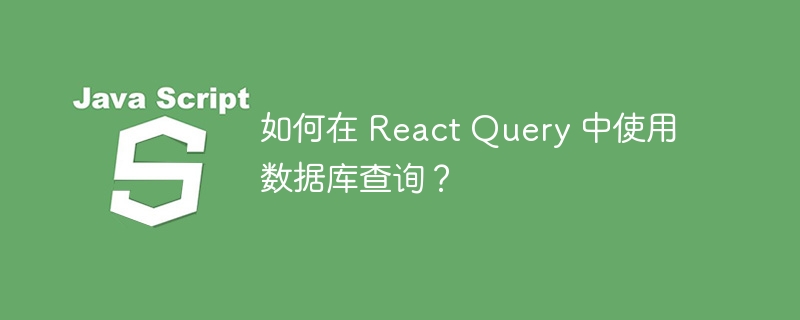

How to use database query in React Query?
Introduction: React Query is a powerful state management library, which is an excellent choice for managing network requests and data caching in React applications. It provides a simple yet powerful way to handle data queries, allowing us to interact with the database easily. This article will give detailed code examples on how to use database queries with React Query.
1. Preparation
Before starting, make sure that React Query has been installed and there is an available database for us to use. This assumes our database is MongoDB, but you can use other types of databases.
2. Create a React Query client
First, we need to create a React Query client to manage our data queries. In the project's entry file (usually index.js), import QueryClient and QueryClientProvider, and create a global React Query client object, and then add It is passed to QueryClientProvider:
import { QueryClient, QueryClientProvider } from 'react-query';
const queryClient = new QueryClient();
ReactDOM.render(
<QueryClientProvider client={queryClient}>
<App />
</QueryClientProvider>,
document.getElementById('root')
); 3. Define the database query function
Before starting to use the database query, we need to encapsulate the database query into a reusable function. This function can accept query parameters and return a Promise, allowing us to use asynchronous functions in React Query. The following is a sample database query function:
async function fetchDataFromDatabase(queryParams) {
return await fetch('/api/query', {
method: 'POST',
body: JSON.stringify(queryParams),
headers: {
'Content-Type': 'application/json'
}
})
.then(response => response.json())
.then(data => {
// 处理从数据库获取的数据
return data;
})
.catch(error => {
// 处理错误
throw new Error('数据库查询失败');
});
}This function is an asynchronous function that uses the fetch API to initiate a POST request to the backend's /api/query interface , and send the query parameters as the request body. It then parses the fetched response data into JSON and returns the data on success, otherwise it throws an error.
4. Using database query in React Query
Now that we have a reusable database query function, we can use React Query in the component to query data.
First, import the useQuery hook function and use it to create a query. We will use the useQuery hook function for data retrieval, passing a query key (usually a string), and a function to trigger the query.
import { useQuery } from 'react-query';
function App() {
const { data, isLoading, error } = useQuery('fetchData', fetchDataFromDatabase);
if (isLoading) {
return <div>Loading...</div>;
}
if (error) {
return <div>Error: {error.message}</div>;
}
return (
<div>
{/* 显示从数据库获取的数据 */}
{data.map(item => (
<div key={item.id}>{item.name}</div>
))}
</div>
);
}In the above code, we use a query key called fetchData and pass the fetchDataFromDatabase function as the query function to useQuery. useQuery The hook function will return an object containing attributes such as data, isLoading and error. We can handle different state.
Through the above code, we can display a loading prompt message according to the isLoading status, display an error message through the error status, and display an error message through the data state to render data obtained from the database.
5. Data rendered in React Query
For data obtained from the database, we can use the data state in the component to render. In the above example, we render each data item fetched from the database as a div element containing id and name.
This is just a simple example, you can perform more complex data rendering according to your application needs.
6. Summary
By using React Query, we can easily use database queries in React applications. In this article, we first created a React Query client, then defined a reusable database query function and used it in the React Query component. Finally, we learned how to handle loading and error messages based on different query statuses and render data fetched from the database.
I hope this article can help you better understand how to use database queries in React Query, and provide some ideas and references for the development of your project. Happy developing with React Query!
The above is the detailed content of How to use database queries with React Query?. For more information, please follow other related articles on the PHP Chinese website!




